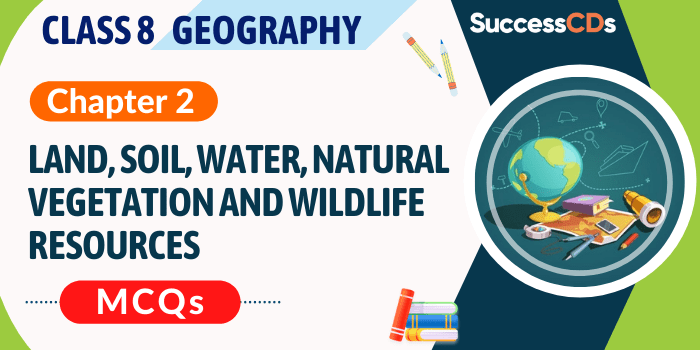CBSE Class 8 Geography Chapter 2 MCQs from Resources and Development Book | Geography Chapter 2 “Land, Soil, Water, Natural Vegetation and Wildlife Resources” Multiple Choice Questions With Answers
Land, Soil, Water, Natural Vegetation and Wildlife Resources MCQs – Here is a compilation of Free MCQs of Class 8 Geography book Resources and Development Chapter 2 Land, Soil, Water, Natural Vegetation and Wildlife Resources. Students can practice free MCQs as have been added by CBSE in the new exam pattern. At the end of Multiple Choice Questions, the answer key has also been provided for your reference. Take Free Online MCQs Test for Class 8.
Click Here for MCQ Video of Land, Soil, Water, Natural Vegetation and Wildlife Resources
| Q1- How much percent of earth’s area is occupied by land?
A) 45 B) 30 C) 66 D) 70 |
| Q2- Private land properties are owned by
A) Cooperative societies B) Individuals C) Communities D) Schools |
| Q3- An example of common property resource is
A) Private homes B) Land for common usage C) agriculture lands of individuals D) factories |
| Q4- Which of the following steps is a major threat to the environment?
A) Planting trees B) Desertification C) Promoting tourism D) Promoting renewable resources |
| Q5- The type of soil is determined by
A) landforms B) soil erosion C) water sources D) Globalisation |
| Q6- As the exposed rock break off and start decaying due to temperature change, this process is called
A) Deforestation B) Landslide C) Soil erosion D) Weathering |
| Q7- Soil is made up of
A) water B) metals C) organic materials & rocks D) ice |
| Q8- Mass movement of rocks down the hills could be a sign ofA) Landslides
B) Floods C) Deforestation D) Weathering |
| Q9- Which of the following states of India are notorious for witnessing maximum number of landslides
A) Punjab B) Uttrakhand C) Tamilnadu D) Jharkhand |
| Q10- How much time is taken to form 1 cm of soil
A) 10+ years B) 5 years C) 100s of year D) few months |
| Q11- Which part of soil is fit for vegetation?
A) Sub soil B) top soil C) weathered rock material D) clay soil |
| Q12- Overgrazing is responsible for causing
A) soil depletion B) Floods C) earthquake D) landslide |
| Q13- Which of the following is used to conserve the soil?
A) Mulching B) Clear the forest C) agriculture process D) cattle grazing |
| Q14- The process of piling up of rocks to prevent water flow is called
A) Rock Dam B) Erosion C) Mulching D) Landslide |
| Q15- The moisture of soil can be retained by the process of
A) Counter Barriers B) Mulching C) Rock Dams D) Planting grass |
| Q16- A dripping tap is capable of wasting approximately how much amount of water per year?
A) 2000 litres B) 1200 litres C) 1500 litres D) 2500 litres |
| Q17- The evaporation of water takes place due to
A) Nitrogen Cycle B) Water Cycle C) Cooling of Ice D) Floods |
| Q18- The zone of earth’s atmosphere where life exists is called
A) Biosphere B) Lithosphere C) Hydrosphere D) Troposphere |
| Q19- The life supporting system is known as
A) earth B) biosphere C) ecosystem D) Vegetation |
| Q20- Which of the following animals are protected under CITES?
A) Monkey B) Dolphins C) Snakes D) Rats |
| Q21- Low-lying areas are susceptible to
A) water logging B) landslides C) illegal mining D) Weathering |
| Q22- ____ are normally sparsely populated.
A) thick forests B) Gangatic plains C) low-lying places D) cultivable areas |
| Q23- The average water consumption per person is ___ cu km/year
A) 5500 B) 6000 C) 6500 D) 5900 |
| Q24- River Yamuna is getting polluted due to
A) industrial affluents B) forests C) weathering D) trees cutting |
| Q25- Rainwater harvesting is compulsory in the state of _____
A) Tamil Nadu B) Haryana C) Rajasthan D) Assam |
| Q26- Terrace farming method is common in ____ regions
A) forest B) mountain C) coastal D) plains |
| Q27- ____ is one of the ways to prevent soil erosion.
A) Trees cutting B) clearing of forest for agriculture C) Counter ploughing D) building dams |
| Q28- ____ is a major threat to the environment.
A) rainfall B) sunlight C) Desertification D) tree plantation |
| Q29- Heavy rains cause _____ in mountainous regions every year.
A) earthquake B) tsunami C) landslide D) accident |
| Q30- ____ are some of the densely populated regions.
A) River plains B) mountains C) thick forests D) deserts |
Answer key for Class 8 Geography Resources and Development book Chapter 2 – Land, Soil, Water, Natural Vegetation and Wildlife Resources
| Question | Answer | Question | Answer |
| 1 | B | 11 | B |
| 2 | B | 12 | A |
| 3 | B | 13 | A |
| 4 | B | 14 | A |
| 5 | A | 15 | B |
| 6 | D | 16 | B |
| 7 | C | 17 | B |
| 8 | A | 18 | A |
| 9 | B | 19 | C |
| 10 | C | 20 | B |
| 21 | A | 22 | A |
| 23 | B | 24 | A |
| 25 | A | 26 | B |
| 27 | C | 28 | C |
| 29 | C | 30 | A |
Class 8 Geography Chapter Wise MCQs
